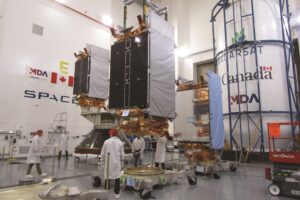MDA Announces Radarsat-2 Continuity Mission
By Debra Werner

SAN FRANCISCO – MDA is designing the follow-on to Radarsat-2, the C-band Synthetic Aperture Radar (SAR) satellite the Canadian firm built through a public-private partnership with the Canadian government.
“We are announcing today that we are well into our project to design and develop our next generation of radar-based Earth observation capabilities to ensure that our Radarsat-2 customers have data and information product continuity moving forward,” MDA CEO Mike Greenley told SpaceNews.
MDA owns and operates Radarsat-2, a taskable satellite that provides imagery and data to government and commercial customers around the world. Radarsat-2, launched in 2007, continues to operate well beyond its seven-year design life.
“We feel it’s important to put up this next generation of commercial capability owned and operated by MDA,” Greenley said.
MDA began working on the Radarsat-2 Continuity Mission approximately six months ago. The company is not yet ready to announce launch plans.
“We are going through all of the detailed designs,” Greenley said. “As we complete our detailed designs, we will provide further information about a schedule.”
As part of the Radarsat-2 Continuity Mission, MDA will rely on its “multi-mission Earth observation ground stations as well as advances in artificial intelligence techniques, including machine learning and deep learning, to manage large volumes of data across multiple sensor platforms and enhance our data analytics capabilities,” according to the Feb. 2 news release.
MDA has built a series of SAR satellites, beginning with Radarsat-1, launched in 1995 and no longer in service.
In 2019, the three-satellite Radarsat Constellation Mission built by MDA for the Canadian government traveled to orbit on a SpaceX Falcon 9 rocket.
MDA provides flight operations and data management services for RCM and other Canadian Space Agency Earth-observation and space situational awareness satellites under a contract announced Jan. 29.
In contrast to the SAR microsatellites entrepreneurs are building around the world, RCM satellites weigh 1,430 kilograms apiece and Radarsat-2 weighs 2,200.
Radarsat-2, a satellite designed for broad-area surveillance, provides more than 75,000 images per year and offers coverage from 144 to 265,000 square kilometers per scene with 20 imaging modes.
February 2, 2021 at 07:30PM
via SpaceNews read more...

Post a Comment